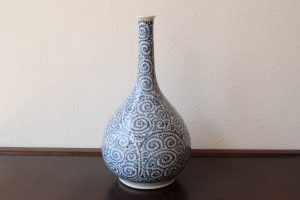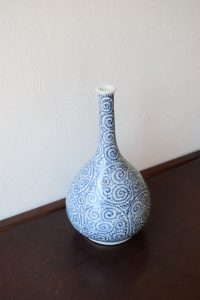蛸唐草文様の花器(愛知県名古屋市千種区姫池通 骨董買取いたします 古美術風光舎名古屋店)
2022.05.22
皆さま、こんにちは。スタッフMです。
朝9時頃にはまだ雨上がりの涼しい風が吹いていたのですが、10時頃になりますとどんどん気温も上がってジリジリと照り付ける日差しでバテてしまいそうです。
外にお出かけになる際は、必ず水分補給をしっかりしながら体調管理を気を付けましょう。
さて、本日は皆さまにお見せしたい作品がございます。

こちらは、蛸唐草文様の花器です。
見ているだけで涼しげな、また存在感のある作品ですよね。
蛸唐草とは、渦巻き状の唐草の片側に、抽象的な葉の文様を付けてあらわされる文様のことです。
蛸唐草文様の原型とされる唐草文様の由来は、古代エジプトまで遡ります。
唐草文様は、古代エジプトから古代オリエント、古代ギリシャ、古代インド、古代中国を経て、飛鳥時代に日本にももたらされました。
古代エジプトでは、蓮をモチーフにした「ロータス」と呼ばれる唐草文様が作られましたが、各国でその土地の文化と結びつき、さまざまな唐草文様が誕生いたしました。
蛸唐草のような、葉のついた唐草文様が見られるようになったのは、10世紀初頭の中国です。
当時中国でつくられた陶器には、そのような文様が多く描かれていました。
日本にこの文様が伝えられたのは鎌倉時代、この葉のついた唐草文様の形が蛸の足のように見えることから「蛸唐草」という呼び名が付けられたということです。
この蛸唐草文様が人気となったのは江戸時代の中頃です。当時、佐賀県や長崎県を中心とした肥前国でつくられていた伊万里焼には、この蛸唐草文様を描いた器が多く作られています。
伊万里焼の人気に伴って蛸唐草も広く知られるようになったのですね。
当時作られた伊万里焼は現代では古伊万里と言われ、コレクションされる方も多いと思われますが伊万里焼に描かれる蛸唐草文様は、時代が下るにつれて、渦や葉の文様が大きくなっていくようで、時代が古いものほど蛸唐草が綿密のようです。
今回のブログは、スタッフMの古美術学習編になりますね。(書いていて今気づきました)
唐草文様は風呂敷などでよく見る柄ではありますが、蛸唐草についてはあまり馴染みが無かったので、とても勉強になりました。
皆さまにもこの”蛸唐草”が少しでも身近なものになりますよう。まずは是非直接見に来てください。
お待ちしております。

Hello everyone. This is Staff M.
The cool breeze after the rain was still blowing around 9 am, but it seems that the temperature will rise steadily around 10 am and the sun will shine. When you go out, be sure to keep hydrated and take care of your physical condition. By the way, today I have a work I would like to show you.
This is a vase with an octopus arabesque pattern. It’s a work that is cool and has a strong presence just by looking at it. Octopus arabesque is a pattern that is expressed by attaching an abstract leaf pattern to one side of the spiral arabesque. The origin of the arabesque pattern, which is said to be the prototype of the octopus arabesque pattern, dates back to ancient Egypt.
The Karakusa pattern was introduced to Japan during the Asuka period from ancient Egypt through ancient Near East, ancient Greece, ancient India, and ancient China. In ancient Egypt, arabesque patterns called “lotus” were made with a lotus motif, but various arabesque patterns were born in each country in connection with the local culture.
It was in China in the early 10th century that arabesque patterns with leaves, such as octopus arabesque, began to be seen. Many such patterns were drawn on pottery made in China at that time. This pattern was introduced to Japan in the Kamakura period, when the shape of this arabesque pattern with leaves looks like an octopus foot, so it was named “Octopus arabesque”.
This octopus arabesque pattern became popular in the middle of the Edo period. At that time, Imari ware, which was made in Hizen Province centered on Saga and Nagasaki prefectures, has many vessels depicting this octopus arabesque pattern. With the popularity of Imari ware, octopus arabesque has become widely known. The Imari ware made at that time is said to be Koimari in modern times, and it seems that many people collect it, but the arabesque pattern of 蛸 Karakusa drawn on Imari ware becomes larger as the times go by. It seems that the older the age, the more meticulous the arabesque.
This blog will be the antique art learning edition of Staff M. (I just noticed it while writing) The arabesque pattern is a pattern that you often see in furoshiki, but I wasn’t very familiar with octopus arabesque, so I learned a lot. I hope this “octopus arabesque” will become familiar to everyone. First of all, please come and see it in person. We’ll be expecting you.
*********************
風光舎では、古美術品や骨董品の他にも絵画や宝石、趣味のお品など様々なジャンルのものを買受しております。
お片付けをされていて、こういうものでもいいのかしらと迷われているものでも、どうぞお気軽にご相談下さいませ。
また風光舎は、出張買取も強化しております。
ご近所はもちろん、愛知県内、岐阜県、三重県その他の県へも出張いたします。
まずは、お電話お待ちしております。
愛知県名古屋市千種区・骨董 買取
『古美術 風光舎 名古屋店』
TEL 052(734)8444
10:00-17:00 OPEN

